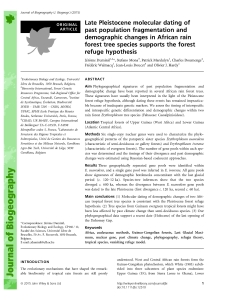Duminil J., Mona S., Mardulyn P., Doumenge C., Walmacq F., Doucet J.L., Hardy O.J.
Aim Phylogeographical signatures of past population fragmentation and demographic change have been reported in several African rain forest trees. These signatures have usually been interpreted in the light of the Pleistocene forest refuge hypothesis, although dating these events has remained impracticable because of inadequate genetic markers. We assess the timing of interspecific and intraspecific genetic differentiation and demographic changes within two rain forest Erythrophleum tree species (Fabaceae: Caesalpinioideae).
Location Tropical forests of Upper Guinea (West Africa) and Lower Guinea (Atlantic Central Africa).
Methods Six single-copy nuclear genes were used to characterize the phylogeographical patterns of the parapatric sister species Erythrophleum suaveolens (characteristic of semi-deciduous or gallery forests) and Erythrophleum ivorense (characteristic of evergreen forests). The number of gene pools within each species was determined and the timings of their divergence and past demographic changes were estimated using Bayesian-based coalescent approaches.
Results Three geographically separated gene pools were identified within E. suaveolens, and a single gene pool was inferred in E. ivorense. All gene pools show signatures of demographic bottlenecks concomitant with the last glacial period (c. 120–12 ka). Species-tree inferences show that the two species diverged c. 600 ka, whereas the divergence between E. suaveolens gene pools was dated to the late Pleistocene (first divergence c. 120 ka, second c. 60 ka).
Main conclusions (1) Molecular dating of demographic changes of two African tropical forest tree species is consistent with the Pleistocene forest refuge hypothesis. (2) Tree species from Guinean evergreen tropical forests might have been less affected by past climate change than semi-deciduous species. (3) Our phylogeographical data support a recent date (Holocene) of the last opening of the Dahomey Gap.
Consultez la notice complète de l’article sur ORBi

